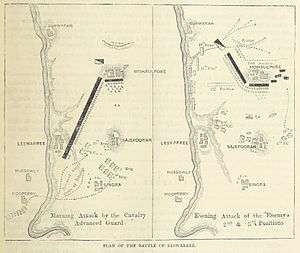Battle of Laswari
| Battle of Laswari | |||||||
|---|---|---|---|---|---|---|---|
| Part of the Second Anglo-Maratha War | |||||||
| |||||||
| Belligerents | |||||||
| British East India Company | Maratha Confederacy | ||||||
| Commanders and leaders | |||||||
| General Lake |
Ambaji Ingle Sindhia Ragojee Bhonsla | ||||||
| Strength | |||||||
|
10,000 Plus an unknown no. of troops from Alwar |
9,000 Infantry 5,000 Cavalry | ||||||
The Battle of Laswari took place on November 1, 1803 near Laswari village, Alwar.[1] It was part of the Second Anglo-Maratha War.
The British under Gerard Lake were anxious to finish the war by neutralizing the last substantial force that the Maratha confederacy possessed, consisting of twelve battalions of regular infantry trained by the adventurer Chevalier Dudrenec. Dudrenec deserted and command fell onto Ambaji Ingle, a Maratha officer.
Lake decided to dispense first with his artillery and later with his infantry in a series of forced marches to catch up with these, he thus initially encountered the enemy force with just three brigades of cavalry, the British troopers by repeated charges were able to contain the Maratha army until their infantry arrived. The British, commanded by Lake were about 10,000 men strong, opposing Sindhia's force of 9,000 veteran infantry and 5,000 cavalry under the command of Abaji. The British were also supported by allied troops from Alwar.

The Maratha infantry made a most gallant defence, standing their ground until the survivors laid down their arms. The cavalry also suffered heavily. Seventy-two guns and a large quantity of ammunition and stores were captured. Lake later wrote "I never was in so severe a business in my life or anything like it… these fellows fought like devils, or rather like heroes".[2]
"The casualties on both sides were very heavy. The Company lost many officers, including Maj. Gen. Weir, Col. Vandeleur, and Maj. Griffith. Lakes's son was also killed."[3]
On 17 December 1803, Raghuji Bhonsale (II) of Nagpur signed the Treaty of Deogaon with the British after the Battle of Laswari and gave up the province of Cuttack including Balasore.
References
- Cooper, Randolph G.S. (2003). The Anglo-Maratha Campaigns and the Contest for India: The Struggle for Control of the South Asian Military Economy. Cambridge University Press. pp. 200–206. ISBN 978-0-521-82444-6.
Coordinates: 27°33′00″N 76°56′00″E / 27.5500°N 76.9333°E